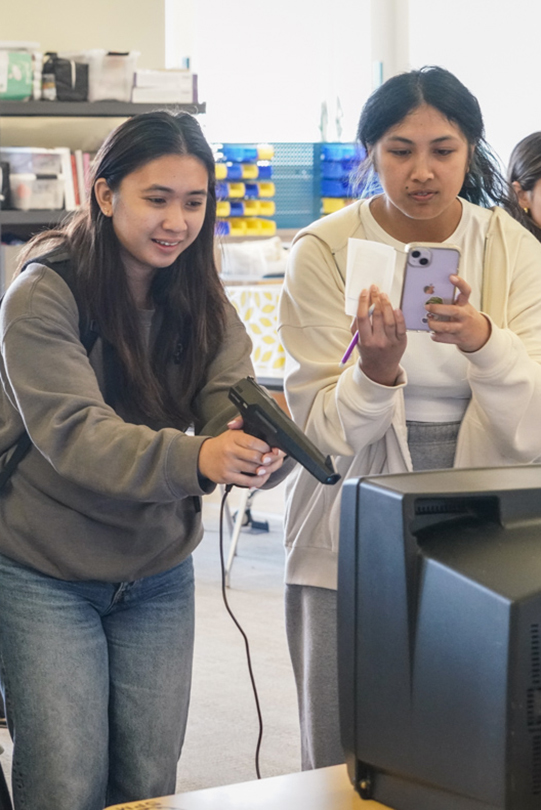
The sound most often heard on Monday mornings at the UC Berkeley Library is the barely stifled yawn, or occasionally, the heavy sigh while turning a textbook page.
But on a recent Monday — at 9 a.m., no less — laughter erupted into the hallway outside the Library Makerspace. Inside, the giggling was punctuated by expressions such as “Ahhhhh, so close” and “Oh, my God,” as well as a few exclamations that wouldn’t be appropriate for this story.
What otherworldly power could energize college students at that early hour?
The electric charm of retro video games.
The students’ visit, one of two interactive play sessions held in 190 Doe Library last week, came as part of the popular course “Video Games and Playful Media.” The class introduces students to the study of games, play, and media, and examines the nature of games and their role in society, said Emma Fraser, an assistant teaching professor in media studies and in the Berkeley Center for New Media.
“My students are studying games history and gaming cultures, and this course allows them to understand some of that history more intimately,” Fraser said. “(They) also analyze games as they were originally played, including elements like character representation.”
If learning outcomes could be evaluated by smiles, the 40-plus students in the class were clearly leveling up on their knowledge. Groups gathered around each of the 10 playing stations, where they could use gaming systems spanning four decades, from the original Atari 2600 (1977) to the Game Boy Advance (2001). Students took turns on the consoles, or played together. They also made notes about their experiences, to be used for an upcoming midterm.






One student, playing the original Super Smash Bros. on Nintendo 64, was feverishly pressing buttons and pleading with his peers, “How do I jump?” In front of the Sega Dreamcast, two classmates discussed insensitive costuming in the legendary fighting game SoulCalibur. When several students got the original Super Mario Bros. working, after some technical issues, one reverently whispered: “It’s kind of beautiful.”
Jenifer Carter, operations lead for the Library’s Media Resources Center, supported Fraser in putting together the event. Carter said 190 Doe was a great fit for the interactive session because of its flexible furniture and numerous power sources. Building on the success of last year’s inaugural event, this year’s session was expanded to multiple days.
“This program is a great example of how the Library can partner with instructors to better understand user needs, and adapt spaces and services to support collaborative learning models,” Carter said.
Fraser lauded the Library’s support as an enthusiastic host of the events, but also for providing most of the older televisions, which are compatible with the consoles, and some of the games.
The Makerspace also ran some complementary programming during the same week, offering video game-themed crafting workshops.
Media studies students Ashley Kua and Sabrina Dargahi were fascinated by playing the games as originally intended. Kua, for example, who had played Super Smash Bros. on a modern gaming console, described the experience on the Nintendo 64 as “very different,” in interface, graphics, and user options. She even noted some lag in the gameplay.
Dargahi said she loved playing Pac-Man on the Atari 2600 console, particularly “the joystick aspect of it.” Kua added that putting the Pac-Man cartridge into the console was “very vintage.”
Fraser characterized these learning moments as “rewarding.” She emphasized that the session is not intended to romanticize the past, but to prepare students for the future, especially those who want to work in the tech or gaming industries.
“When you use an earlier technology, it often helps you to better understand the design and function of new technology, and what the different upgrades and software really mean to us as users,” Fraser said. “It really helps to put a lot of contemporary things into a new light.”